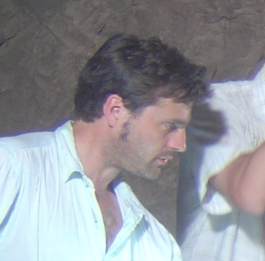Oasis
The first time I went to
It turned out there was a seldom visited, unexcavated temple outside Dahkla oasis. Over the millennia the oases shrank leaving the temple “stranded” in sand- miles from the contemporary greenery. Intending to find this relic, I headed to the oasis with little information, and upon arriving immediately encountered a faded sign with a crude map of the area. Sure enough a temple was indicated by an image of a gateway far out in the desert.
I set out the next morning on the road leading into “The Great Sand Sea”. Well, the “map” significantly glossed the distances and hours later I was still walking on the empty road. I was surprised to come upon a solitary man heading into the intermittent fields on the right at this still marginal area of patchy cultivation and desert. I gestured the shape of the gate and he pointed out into the desert to the left but also somewhat back the way I came. I had apparently significantly overshot. His indication was a cleft in a ridge out on the horizon. Off I went, by now it was the heat of the day and my water was long gone, but I wasn’t to be deterred. I crossed a huge expanse of deserted and dried fields, which ominously seemed to have lost a battle with the sun. By the time I reached the ridge I was hurrying to finally arrive because I knew without water I couldn’t linger. Cresting the ridge, at last there was the temple off in the distance sprawled majestically amidst the blowing sand. Indeed it was every bit the romantic image from another era. I plunged onward determined that I would look around and quickly sketch something before turning back. I knew how far I had come and I knew it was going to be a long, difficult time before I got any water so I was intent to at least make it all worth it. Finally arriving, distractedly thirsty, I darted amongst the porticos and settled in a sliver of shade under a cornice to draw the main gate. Sketching quickly and anxiously I drew two views as best I could, thinking of nothing but water- then packed up and started moving fast. My outbound route had been indirect because I followed the road and the fastest route back was right across the desert. But after 45 more minutes of infernal heat, slogging over immense dunes and more parched fields I knew I was in real trouble and was genuinely scared. In a worst case scenario I needed to be on the road and not in the desert and I switched my direction straight at it. Perhaps an hour later it came in view and I had only walked a few hundred yards when I heard a motorcycle. I don’t know how I was acting, but I didn’t need to say anything. The man riding just stopped and gestured for me to get on.
In town when I had recovered I went back to my sketchbook to view the drawings. What I saw chilled me. I had made the two drawings offset slightly but superimposed right on top of each other on the same piece of paper despite having had plenty. I was unaware I had done this, and it certainly wasn’t intentional. The fact that I could “focus” on rendering lines of an image and not detect that I was putting a layer of new lines over existing lines is an indicator that my mental faculties were not functioning normally. Dehydration or heat stroke had put me in much greater danger than I realized at the time.
Over the years I’ve often contemplated that weirdly layered image. The unnecessary redundancy of the perceptions and representations on one hand approaches a tautology and on the other is intriguing for exactly that reason. Indeed, the drawings encapsulate issues of representation in general. Are they representations of an “original” or is one a representation of the other in which case which is the original and which is the copy? Does a second instance add any additional information to the first? In the emphatic-ness implied by the repetition, what is still being left out, un-represented? In being repetitions of representations of a single object, signs for that object, what is to be made of any differences between the representations? If a second representation added nothing and thus was empty and tautological, which of the two is the tautology? Perhaps the pair is a botched stereogram, a snapshot of wall-eyed binocular vision? What is really going on cognitively that allowed this split between awareness and perception? What information and codes are steadily sneaking through perception via the senses- but remain below the threshold of awareness, a threshold that was accidentally recorded and exposed by a stupor at the limits of consciousness?
Similar oddly emphatic, near-tautological representations stalk much of my work through the years. This is treacherous terrain of a different sort to traverse. Frankly, too many of my attempts are parched in the dryness of illustration. One series of small interventions is an example that may have run this risk and escaped. I attached business-card sized drawings of infrastructure directly to the objects represented in the drawings. Many were parking meters, others were bus stops, electric switches, cross walk buttons etc. The locations involved the likelihood of people looking at and even touching the images in the course of interacting with the “parent” object. The obviousness of this given lineage rubs against the tautological, perhaps from a “who cares” aspect but also from a “why”? Why do I need a parking meter drawing attached to my parking meter? Why do I need a drawing of a temple on top of my drawing of a temple?
...


0 Comments:
Post a Comment
<< Home